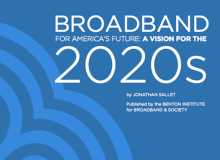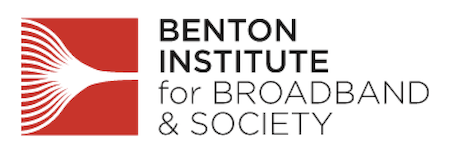
Fast, affordable Internet access for all.

The Benton Institute for Broadband & Society has a reputation for looking at today’s reality with an eye toward tomorrow’s needs. In their report, Broadband for America’s Future: A Vision for the 2020s, Benton Senior Fellow Johnathan Sallet continues that perspective and offers insightful recommendations for a new National Broadband Agenda.
Download the report, Broadband for America’s Future: A Vision for the 2020s here.
Broadband for All Needs a New Approach
As access to high-quality connectivity becomes more critical each day, those without fast, affordable, reliable Internet access lose ground more quickly as time passes. In addition to the opportunities that come with broadband access, lack of adoption translates into lack of technical skills. Innovation isn’t slowing down for folks who don’t have broadband.
As Sallet notes, access to and adoption of broadband improves our economy, strengthens communities, and empowers American workers. Obtaining that access and expanding that adoption, however, is proving more challenging than it should be.
In his report, the author reviews in detail the barriers that have prevented the U.S. from achieving its goal of ubiquitous access and adoption of broadband. He’s able to make recommendations based on four key policy areas:
Deployment of networks where adequate broadband does not exist;
Competition to increase choices and spur lower prices and better-quality service to their residents;
Affordability and Adoption for those who wish to have broadband in their homes but lack the means or the skills to acquire it; and
Community Anchor Institutions, such as schools and libraries, that increasingly serve their users wherever they are.
Deploying Better Networks, Creating Choice
In addition to better data collection in order to know where Internet access is inadequate, Sallet writes that policymakers and citizens should also have access to information about Internet access that hasn't been collected to date. Performance measures such as latency, data caps, and pricing, all contribute to adoption and access in both rural and urban environments. His report urges that all Americans have access to the type of Internet access that offers characteristics of fiber-based networks.
Sallet also recommends that the industry and policy makers reconsider the negative implications of the term "overbuilding":
There is a tendency to call the construction of new, competitive networks in a locality with an existing network “overbuilding,” as if it were an unnecessary thing, a useless piece of engineering. But what some call “overbuilding” should be called by a more familiar term: “Competition.” “Overbuilding” is an engineering concept. “Competition” is an economic concept that helps consumers because it shifts the focus from counting broadband networks to counting the dollars that consumers save when they have competitive choices.
More robust competition is the foundation of an effective and universal broadband agenda for the 2020s. As Sallet writes in his report:
Today, concerns about competition in the broadband marketplace are real. Consider this: Many Americans have access to and many subscribe to broadband service with download speeds of 100 Mbps or above. According to the FCC data collection (which systematically overcounts broadband deployment), competition among providers offering 100 Mbps download broadband is slight: 83 percent of the population either live in an area with no service or are served by a monopoly or a duopoly.
With limited competition, it is perhaps unsurprising that Americans pay some of the highest broadband prices in the world. Among the 35 OECD countries studied, America was the second most expensive in 2017. p.43
Sallet used Wilson, North Carolina, and the information we documented in our 2012 report, Carolina's Connected Community: Wilson Gives Greenlight to Fast Internet. The incumbent held prices steady when it faced competition from Greenlight Community Broadband, the local municipal Fiber-to-the-Home (FTTH) network.
The need to encourage competition is a common thread throughout the Benton report. As Christopher noted:
This report is path-breaking with its commitment to real competition in an industry that talks about choice constantly while failing to deliver. Sallet and the Benton Foundation make a compelling case for thoughtful government policy that will create competition rather than continuing the status quo of hoping competition will materialize merely from removing some regulations on incumbent operators.
Affordability, Adoption, Community Anchor Institutions
 Even if high-quality Internet access is available in the community, often there are citizens who can't afford to take advantage of it. Sallet recommends that the FCC and Congress strengthen the use of Lifeline and go a step farther to create more support for funds to connect low-income citizens at home. He also suggests that entities that receive broadband deployment funding from the federal government offer low-cost broadband access as a condition of receiving that funding.
Even if high-quality Internet access is available in the community, often there are citizens who can't afford to take advantage of it. Sallet recommends that the FCC and Congress strengthen the use of Lifeline and go a step farther to create more support for funds to connect low-income citizens at home. He also suggests that entities that receive broadband deployment funding from the federal government offer low-cost broadband access as a condition of receiving that funding.
The report reveals several examples of how local communities have established affordable Internet access for low-income households, including the partnership between San Francisco and private ISP Monkeybrains. We wrote about the effort to bring broadband to people in affordable housing in our 2019 report, A Public Housing Digital Inclusion Blueprint: Monkeybrains and San Francisco Deliver a Sustainable Gig.
Providing digital skills training can achieve the best results on the local level with support from federal entities. The Benton report also recommends that digital skills training be targeted, continuous, measurable, and connected to economic growth strategies.
The report notes that:
In the 2020s, public policy should recognize that bits are books, bits are blackboards, and bits are basic tools of medical practice. Community anchors’ missions are moving beyond their walls. Libraries no longer deliver knowledge that is housed only within their buildings or the covers of hardbound books. Public education today cannot exist separate from the ability of students and teachers to use broadband connections—both in and out of school. And health-care facilities see and monitor patients both in hospitals and in their homes. p.86
A few of the recommendation from Sallet and Benton include:
- Community anchor institutions need competitively priced, High-Performance Broadband...More competition is the answer.
- Community anchor institutions need to reach people wherever they are—both within and outside the buildings that house these institutions....Publicly funded, middle-mile networks that connect community anchor institutions should be open to broadband providers willing to offer “last-mile” service to community residents and businesses
- The High-Performance Broadband networks that connect community anchor institutions can be used as launching pads for new, community-wide service....There is no reason to wait any longer. Congress and the FCC should expand the E-Rate program to provide wireless access to students of lower-income families who do not have broadband at home. At current prices, $100 million per year would support the full cost of LTE service to between two million and three million K-12 students.
"The Same Fabric of Truth-Seeking"
The 150-page report provides examples of successes, challenges, and many more detailed recommendations for a forward-thinking broadband policy agenda. As the author notes, extending high-performance broadband to all of America's citizens has become a necessary goal to advance our democracy and social justice. He writes:
The use of High-Performance Broadband will help America achieve both economic and social outcomes. This report stresses that one important means of improving access to broadband is to give consumers more and better choices by promoting greater competition. At a fundamental level, the ideas of a competitive market and the idea of democracy are woven from the same fabric of truth-seeking—the same idea from which science, technology, democracy, and competition all emerge.
...
The strength of High-Performance Broadband is that it will—if fully accessible to all in America—help us solve some of our most critical societal challenges, meet people wherever they live and work, and help them overcome key barriers regardless of their background, community surroundings, or demographic characteristics. Imagine each community enabled to identify and build on its strengths and employ technology accordingly. That is a profoundly democratic vision.
Download the full report here [PDF].
You can also download the Full Executive Summary here [PDF] and the One Sheet Summary here [PDF]. Visit the report site for more details.
